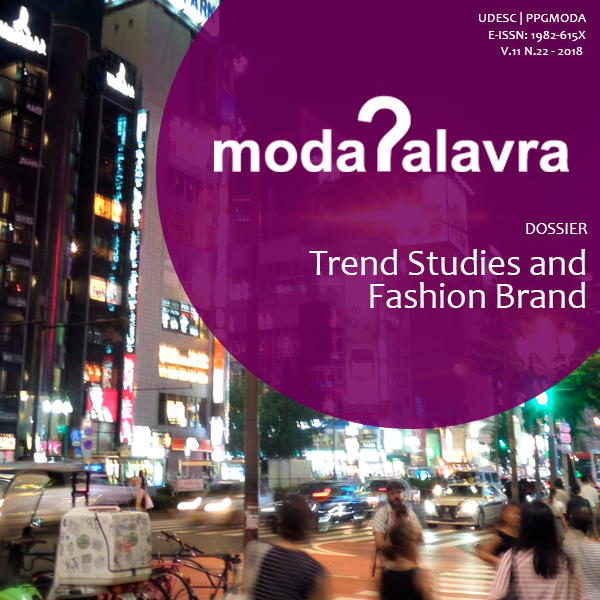About Being-Together With As a Sociocultural Tendency and Creative Collectives: an interdisciplinary proposal of methodology for identifying trends for future scenarios
DOI:
https://doi.org/10.5965/1982615x11222018113Keywords:
sociocultural tendencies, creative collectives, creative economy, future scenariosAbstract
This article focuses on a proposal for a methodology to identify sociocultural trends and their consequences. To develop this objective, we approach the understanding of trends, especially from a sociological perspective. In opening this perspective, we introduce our understanding that sociocultural tendencies are social sensitivities, and thus establish the principles for the emergence of social forms, values, and other tendencies. The understanding of this relationship is essential because it leads us to address the correspondence between the object of study of this research - the Creative Collectives - and the sociocultural tendency being-together-with. Having established the connections between these instances, the work addresses the immanent relationship among them and the emergence of the creative economy also treated here as the economy of culture. After weaving these affinities, we present the future scenarios tool and locate its use in the methodological proposal that we deploy. This proposal is based on principles of comprehensive sociology, interpretive anthropology, and Dialogism, having in the future scenarios a visualization mechanism, through narrative, of development for elements identified in loco in Creative Collectives of the city of Porto Alegre.
Downloads
References
Referências Bibliográficas
BAKHTIN, Mikhail. Problemas na poética de Dostoiévski.4.ed. Rio de Janeiro: Forense Universitária, 2008.
BERGER, Peter. L., LUCKMANN, Thomas. A construção social da realidade.Petrópolis: Vozes, 2009.
BORDIEU, Pierre. O poder simbólico.11a. ed. Rio de Janeiro: Bertrand Brasil, 2007.
CALDAS, Dario. Observatório de sinais: teoria e prática da pesquisa de tendências.Rio de Janeiro: Editora Senac, 2004.
DE MASI, Domenico. Criatividade e grupos criativos: descoberta e invenção. Vol. 1. Rio de Janeiro: Sextante, 2003.
ECO, Umberto. Os limites da interpretação. 2 ed. São Paulo: Editora Perspectiva, 2012.
FLORIDA, Richard. A ascensão da classe criativa. Porto Alegre: L&PM Editores, 2011.
FOUCAULT, Michael. A ordem do discurso: aula inaugural no Collège de France, pronunciada em 2 de dezembro de 1970. 16.ed. São Paulo: Loyola: 2008.
FRANZATO, Carlo. et all. Inovação cultural e social: design estratégico e ecossistemas criativos. In FREIRE, Karine Mello (org) Design estratégico para inovação cultural e social. 1ed. São Paulo: Editora Kazuá, 2015.
GARNHAM, Nicholas. De las industrias culturales a las creativas. Análisis de las implicaciones en el Reino Unido. In BUSTAMENTE, Enrique. (org). Las Industrias Creativas: Amenazas sobre la cultura digital. 1 ed. Barcelona: Gedisa Editorial, 2011.
GEERTZ, Clifford. A interpretação das culturas. 1 ed.Rio de Janeiro: Zahar Editores, 2008.
MAFFESOLI, Michel. O conhecimento comum. São Paulo: Editora Brasiliense,1988.
______________. Mediações simbólicas: a imagem como vincula social. In: Revista Famecos, n. 8, pp. 7-14, jul. 1998.
______________. O tempo das tribos. 2002. 3.ed. Rio de Janeiro: Forense Universitária, 2002.
_____________. O tempo retorna: formas elementares da pós-modernidade. Rio De Janeiro, Forense, 2012.
MASSONNIER, Verónica. Tendencias de mercado: están pasando cosas. Buenos Aires: Ediciones Granica, 2008.
MORIN, Edgar. O método vol. 4.As ideias. vida, costumes. Porto Alegre: Sulina, 2011.
NIETZSCHE, Friederich. A origem da tragédia. São Paulo: Ed.Centauro, 2004.
REIMÃO, Sandra. Teoria ou teorias da comunicação.In: Revista INTERCOM, v. 17, nº 2. São Paulo, jul/dez. 1994.
REYES, Paulo Bello. Projeto por Cenários. In Design Estratégico em Ação. SCALETSKY, C. C. org. São Leopoldo: Editora Unisinos, 2016.
SIMMEL, Georg. Questões fundamentais da sociologia.Rio de Janeiro: Jorge Zahar, 2006.
TREMBLAY, Gaëtan. Desde la teoria de las industrias culturales.Evaluación critica de la economia de la creatividad.In: Bustamente, E. (org). Las industrias creativas: amenazas sobre la cultura digital. 1 ed. Barcelona: Gedisa Editorial, 2011.
YÚDICE, George. A conveniência da cultura. Usos da cultura na era global. Belo Horizonte: Editora UFMG, 2014.
Downloads
Published
How to Cite
Issue
Section
License
Copyright (c) 2018 Paula Cristina Visoná

This work is licensed under a Creative Commons Attribution-NonCommercial 4.0 International License.
When submitting an article for publication in ModaPalavra e-periodico, the author (s) agree (s) with the following terms:
- Authors maintain the copyright in their manuscripts and grant the journal the right of first publication, with work simultaneously licensed under the Creative Commons Attribution-NonCommercial 4.0 International, which allows sharing the work with the acknowledgment of authorship and the initial publication in the journal without payment ;
- Authors may use the same results in other publications after the first publication, provided that they indicate ModaPalavra e-journal as the original publication medium;
- Authors are authorized to take additional contracts, separately, only after the original publication in ModaPalavra e-journal, provided they indicate ModaPalavra e-journal as the original publication medium;
- Authors are allowed and encouraged to publish and distribute their work online (eg in institutional repositories or on their personal page), only after the editorial process and the first publication, provided they indicate ModaPalavra e-journal as the original publication medium;
- To indicate ModaPalavra e-journal as the original publication medium, authors should use the following text template: "This article was originally published by ModaPalavra e-periodical, under a CC BY NC license, in its volume [insert volume] number [insert number] in the year of [insert year], and can be accessed at: http://www.revistas.udesc.br/index.php/modapalavra/ ";
- The opinions expressed in the articles are the author’s sole responsibility, not necessarily reflecting the journal’s opinion. The publication of any material that is owned and held in copyright by a third party, including – but not limited to - articles, photos or drawings was previously authorized by their representatives to be published in ModaPalavra e-journal.









